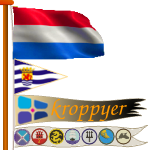Login
Support Sailonline
If you haven't already - join the SAILONLINE YACHT CLUB!
Please also consider making a donation - all amounts are greatly appreciated!
Page: First Previous 6 7 8 9 10 11 12 Next Last
|
Posted by kroppyer  |
|
|
It's gotten a bit long... We might need a separate topic in which to discuss a possible new performance model.
!! When I talk about a "(possible) new (performance) model", I am not saying there will be a new model. We can just think and dream at this point. I agree that a practical, realistic model needs another boat-specific parameter, like weight. Since we're talking about boats, weight and water displacement are about the same, so together with the values in the polar (boatspeed), a realistic model can be made that uses ideas from real physics (momentum, kinetic energy). The introduction of a new parameter is probably a lot of work: the database needs to be altered, some code-structures need to be changed. If we want the client to show the parameter (for sake of transparency), the client needs to be altered, including protocols between server and client, which might "break" (parts of) other software (like brainaid's). This is assuming we keep using the percentage, as-is. That could be changed too. Since we're speaking about realism, momentum and/or kinetic energy could be a better base for the performance model, a percentage is not really realistic in the first place. Changing this is probably even harder, with more implications. This is not a reason not to change, it's a reason to think well, do the calculations, discuss, simulate and try a lot before deciding upon "officially" presenting the idea to SOL/dev dudes. So, it's going to take a while, and we should take the time. I don't think an intermediate (small) change (like removing the 93% rule) is wise, because: - the current model is effective - I'd like to keep "changing performance models" to a minimum. So when we change it, it'd better be for the long term. So, (as far as I'm concerned), we're not changing the performance model until we have a long term alternative. The 93% rule is not realistic, but it's definitely not the only thing, and probably not even the most important thing that makes it unrealistic. I don't fully agree with Rods theory about slowing down. Of course, when in a straight line, heavy boats don't slow down as much as light boats. But we're talking about turning the boat here. I don't think slowing down in a turn is really influenced by the mass of the boat. Before I go on and describe some of my ideas, I'd like to draw the attention to A2R's post, it's exactly how I think about the matter, and it's the main inspiration of the seconds of two ideas that will follow. Click for A2R's post @ 2013-12-20 20:18:19 ---- Idea#1 (this is JUST an IDEA): I propose to store with each boat/polar the weight of the boat. Ideally this should be the actual weight, but the boat/polar designer is free to change the weight of the boat so that its performance is more realistic. The performance loss will be calculated using difference in cc and whether the boat has changed tack. With a 90 degree turn, there'll be a performance loss of 40% to 80% (so performance will drop to 60% to 20%). When the boat gybed or tacked an additional performance hit (of about 10% to 20%) is calculated. Performance cannot drop below 0%. The recovery of this performance loss will depend on the weight of the boat. A light weight boat (like a laser dinghy) will have gone up to speed in the next server jump (10-15 seconds later. A heavy ship (like our 90m barque) will need some more time to get up to speed again. The recovery does not need to be linear. Idea#2 (this is JUST another IDEA): Alternatively, we can step away from the performance percentage, and allow for an even more realistic model. A function of mass and speed will give a number (like momentum, or kinetic energy). It'll cost time to change this number. Example: We need the same weight parameter from the previous idea. We'll use momentum, to keep the calculation simple. mass: 100 speed: 10 => momentum: 10*100 = 1000 Now we change angle, in which we lose some momentum, let's say we lose 600. And the polar says that at this angle, our speed should be 14 knots. So directly after the turn: mass: 100 momentum: 400 => speed: 4 After some time, when momentum had the chance to adapt to the new angle: mass: 100 speed: 14 => momentum: 14*100=1400 New, let's say we change angle again, but now to a very slow angle (upwind), at which the polar gives 4 knots. In the turn we lose, let's say, 500 "momentum". So directly after the turn: mass: 100 momentum: 900 => speed: 9 After some time, when the momentum had the time to change: mass: 100 speed: 4 momentum: 4*100 = 400. The drop in momentum could be a percentage that is determined as I described the the first idea. The recovery of momentum is the main thing to figure out in this example. __________ I hope this will trigger people to share (more) ideas, think about the consequences, and slowly results in a new performance model that we can then present to the dev dudes. It's quite possible that they say "Oh no.. we're not going to do that any time soon" __________ I DON'T say I want the performance model changed, I am just trying to help those who what it to change to create a better model. I DON'T say that creating a better model will result in implementation of this model, I am just trying to explore the possibilities with you. --- Last Edited by kroppyer at 2018-16-21 15:76:42 --- |
|
|
Posted by Klyvarn |
|
|
I agree with you, Rod, with over 93%
I am sure you have made turning and tacking tests. I am 100% sure that the performance model is unrealistic. I just made one in the Christmas Race. Tack/Gybe from TWA 45 to -130.268 in TWS 5.87 knots the performance went to 96.08 from 100. After gaining performance to 100%, making a 100.268(the .268 is to be sure to get just over 7% performance to loose) degree turn from -130.268 to -30 TWA (without any boatspeed involved in the calculation ??) the holy 93% performance appears. Why has the boatspeed lost influence if you turn your boat? Sailing VMG upwind in your VO74_v4 you need TWS 28.1(at 45.5 TWA)and downwind TWS 12.47 (at 138.68 TWA), then you reach the 7.01% performance-loss. Is a gybe that much more difficult to make than a tack. I am not trying to explain the performance model, just trying to understand. I think every SOLer wants a game as realistic as possible, as fair as possible. A2R, has really something there with the boat specific momentum coefficient. It seems to me that we may start a performance brainstorming thread |
|
|
Posted by Rod |
|
|
There is an aspect of the gybing part of the PL problem that has not been considered so far. I speak from the experience of radio-controlled model sailing yachts, specifically the Soling One Meter.
When gybing, one usually pulls in both main and jib sheets (using a fairly powerful 'sail winch' servo, capable of pulling in the sheets in a wind up to approx 20 kn). One then turns down wind, usually with little or no loss of boat speed, and the sails promptly gybe. The sheets are then let out to the required amount, as the boat continues to turn onto the new course. All of this occurs with little or no loss of boat speed. If someone has a similar description of the gybing behaviour of small, medium, and large yachts, as well as 90 meter clipper ships, perhaps their knowledge might be incorporated into any model that may be chosen in the future to describe a realistic Performance Loss for SOL If it breaks, it's not strong enough--if it doesn't, it's too heavy. |
|
|
Posted by kroppyer  |
|
|
Depending on the type of boat, and the wind strength, gybing and tacking can be without noticeable loss, sometimes even with a gain (roll-tacking/gybing in dinghies).
I am encouraging a performance model in which we have performance big performance losses, and fast recoveries. Rather than a gybe, in which the speed does not drop below 90% of the max speed, but it still takes over 20 minutes to get back up to speed, as is the case now. More realistic is a performance hit of 50%, and a recovery of about a minute (of course depending on the boat an other factors). Attached, description, graphs and other stuff about the current performance model. Also, the "source", so that people can change the document and use it for other purposes if they want. No strings attached, as long as you're not going make money of my work, by selling it |
|
|
Posted by Klyvarn |
|
|
Great thanks Kroppyer, for making us nice instruction files.
The mass * boatspeed = momentum idea, let's think further of that. Which variables have greatest impact on recovery? I am very pleased to see the direction this thread has taken lately. Now we are discussing realistic changements to SOL instead of preventing "tacking gamers". Thank you. Is it possible that the "dev dudes" correct current gybe/tack formula to the more accurate e = 1.0-(aftergybe.bs*current performance)/200.0. --- Last Edited by Klyvarn at 2013-12-22 10:39:41 --- |
|
|
Posted by JB  |
|
|
I was preparing time ago some thoughts about this subject.
The attached file has my words about it, and they go with Kroppyer. Sail Fair. |
|
|
Posted by Karri |
|
|
IMHO, the current performance system has the following pros:
1. It is same for all boats 2. The basics are relatively simple 3. My understanding is that from a game engine perspective it is easy to implement and the following cons: 1. The extent to which it simulates reality is limited 2. While the basics are simple, estimating the impact of any given maneuver is not Now, whether the system should be changed, that's another story. To me the system is one part of the game mechanics, the rules, and as such it does not seem to function too badly. If it ain't broken, at least think what you're trying to fix. My opinions may have changed, but not the fact that I'm right. |
|
|
Posted by Jawz  |
|
|
Hi SOLts!
Does anyone know if there is any minute advantage gained by sailing CC vs sailing TWA. What I really want to know is this "Does sailing on TWA, where the game engine makes continuous small changes, cause any small performance loss? Thus, over a 6 hour period all the very small hits on performance loss adds up to a loss of a yard?" Been sailing here for years now and I still dont know if this is of any concern or not. So, be honest and let me know |
|
|
Posted by kroppyer  |
|
|
Not entirely sure about whether performance loss is calculated when sailing normal twa or cc.
I actually think that performance loss is calculated from twa, so cc is the type of command with the invisible performance loss. We sailing cc in a windshift, so that the boat auto-gybes, performanceloss is calculated. Other than that, the performance loss from continuous twa changes (or cog changes) will be insignificant. Before you worry about such small performance losses, you will have so many DCs, following an exact course, that is doesn't matter anymore whether you use cc or twa. I can give you the numbers and everyting, but I think the conclusion is more interesting. Disclaimer: though I am an admin, I have no knowledge about the sailonline code (including performance loss) that isn't available to normal users, so the above is might be wrong (i would be extremely surprised though). |
|
|
Posted by Rod |
|
|
I have been thinking (deeply, of course) about the practical aspects of the performance loss problem, and have concluded that one aspect is missing (It is possible I could calculate it, but not instantaneously!!)
The info really needed is the angle of turn which would produce a perf loss of about 8% at any given speed. This would allow the SOLer to divide any turn into two parts, so that a tack or gybe would result in no perf loss greater than c. 8%. This seems like an obvious tool to use, if it was in the form of a graph, showing a line for each of tack and gybe, with the margin (8% rather than 7%) of turn needed to allow for the keyboard entry of the second part of the turn before the perf loss is decreased to below 7%. SOLers could place this graph beside their computer work stations as a sheet of paper, or have it as an extra Window on their computer screens along with the SOL map. I would do this myself, but would prefer it done by someone a bit younger and more mathematically inclined---like Kroppyer???? --- Last Edited by Rod at 2014-07-17 16:47:37 --- --- Last Edited by Rod at 2014-07-17 18:19:39 --- If it breaks, it's not strong enough--if it doesn't, it's too heavy. |
Page: First Previous 6 7 8 9 10 11 12 Next Last
Please login to post a reply.Races
Next Race: 00d 00h 00m
Current Races:
Fernando de Noronha to Faroe 2025

PRIZE: SMPF
Race #1960
INFO by brainaid.de
Ragamuffin 100 PARTICULARS
WX Updates:
0430 / 1030 / 1630 / 2230
Ranking: RWW - OCQ4 - OCCH - SUPSOL - SYC
Race starts: Nov 03rd 11:00 Registration Open!
GO TO RACE
Mistli's Birthday BBQ Race 2025

Welcome to one of Sailonline's great traditions - the ofttimes slightly untimely celebration of SOLer Mistli's birthday on November 1, by way of a tricky race through the Stockholm Archipelago. To match the day that’s in it, this year correctly, we are providing you with a fleet of sleek 11 metre 1-designs (get it?) to slice through these (at least) 61.5nm of SLI-infested waters, and give you a fair chance that there will still be some beer left by the time you moor up by the jetty at Trosa!
Race #1947
INFO by brainaid.de
11m OD PARTICULARS
WX Updates:
0430 / 1030 / 1630 / 2230
Ranking: SYC
Race starts: Nov 01st 14:00 Registration Open!
GO TO RACE
ORCV Melbourne to Devonport Race 2025

Race #1951
INFO by brainaid.de
Swan 36 PARTICULARS
WX Updates:
0430 / 1030 / 1630 / 2230
Ranking: SYC
Race starts: Oct 31st 03:30 Registration Open!
GO TO RACE
Sinbad by Balloon 2025 - Carnarvon to Dondra
From here, our home in Bharatavarṣa is now north west of us – said Sinbad to his fellow balloonists. Perhaps we can ride the wind first further north, and then catch the winds that every year bring the rain, perhaps not. It’s 2600nm and we could be aloft awhile, so, Master el-Quarters, victuals only, no sandbags, provisioning the giant hamper. It will be not a picnic!
Race #1886
INFOby brainaid.de
SOL Balloon PARTICULARS
WX Updates:
0430 / 1030 / 1630 / 2230
Ranking: SYC - SBB
Race starts: Oct 15th 11:00 Registration Closed
GO TO RACE
SYC Ranking
Series
- SYC ranking
- 2025 TS
- 2025 TRQ4
- 2025 TRQ3
- 2025 TRQ2
- 2025 TRQ1
- 2025 TRCH
- 2025 TD
- 2025 SuperSOLer
- 2025 SSANZ
- 2025 SPRCH
- 2025 SPQ4
- 2025 SPQ3
- 2025 SPQ2
- 2025 SPQ1
- 2025 SHE
- 2025 SBB
- 2025 RWW
- 2025 RMI
- 2025 RED
- 2025 OCQ4
- 2025 OCQ3
- 2025 OCQ2
- 2025 OCQ1
- 2025 OCCH
- 2025 NT
- 2025 LOOR
- 2025 DN
- 2025 B2B
- 2025 ARQ4
- 2025 ARQ3
- 2025 ARQ2
- 2025 ARQ1
- 2025 ARCH
- 2025 ABS
- 2024 TS
- 2024 TRQ4
- 2024 TRQ3
- 2024 TRQ2
- 2024 TRQ1
- 2024 TRCH
- 2024 TD
- 2024 SVF
- 2024 SUPerSOLer
- 2024 SSANZ
- 2024 SPRQ4
- 2024 SPRQ3
- 2024 SPRQ2
- 2024 SPRQ1
- 2024 SPRCH
- 2024 SHE
- 2024 RTW
- 2024 RMS
- 2024 OCQ4
- 2024 OCQ3
- 2024 OCQ2
- 2024 OCQ1
- 2024 OCCH
- 2024 LOOR
- 2024 HILAT
- 2024 GWT
- 2024 DN
- 2024 CRW
- 2024 B2B
- 2024 ARQ4
- 2024 ARQ3
- 2024 ARQ2
- 2024 ARQ1
- 2024 ARCH
- 2023 TS
- 2023 TRQ4
- 2023 TRQ3
- 2023 TRQ2
- 2023 TRQ1
- 2023 TRCH
- 2023 TD
- 2023 SVS
- 2023 SUPerSOLer
- 2023 SSANZ
- 2023 SPRQ4
- 2023 SPRQ3
- 2023 SPRQ2
- 2023 SPRQ1
- 2023 SPRCH
- 2023 SHE
- 2023 RTW
- 2023 RNI
- 2023 RMS
- 2023 PIC
- 2023 OCQ4
- 2023 OCQ3
- 2023 OCQ2
- 2023 OCQ1
- 2023 OCCH
- 2023 LOOR
- 2023 DN
- 2023 ARQ4
- 2023 ARQ3
- 2023 ARQ2
- 2023 ARQ1
- 2023 ARCH
- 2022 TRQ4
- 2022 TRQ3
- 2022 TRQ2
- 2022 TRQ1
- 2022 TRCH
- 2022 TD
- 2022 Tall Ships
- 2022 SUPerSOLer
- 2022 SSANZ
- 2022 SSA
- 2022 SPRQ4
- 2022 SPRQ3
- 2022 SPRQ2
- 2022 SPRQ1
- 2022 SPRCH
- 2022 SHE
- 2022 OCQ4
- 2022 OCQ3
- 2022 OCQ2
- 2022 OCQ1
- 2022 OCCH
- 2022 NTR
- 2022 LOOR
- 2022 CTR
- 2022 ARQ4
- 2022 ARQ3
- 2022 ARQ2
- 2022 ARQ1
- 2022 ARCH
- 2021 TRQ4
- 2021 TRQ3
- 2021 TRQ2
- 2021 TRQ1
- 2021 TRCH
- 2021 TD
- 2021 Tall Ships
- 2021 SYCQ4
- 2021 SYCQ3
- 2021 SYCQ2
- 2021 SYCQ1
- 2021 SYCCH
- 2021 SUPerSOLer
- 2021 SSANZ
- 2021 SPRQ4
- 2021 SPRQ3
- 2021 SPRQ2
- 2021 SPRQ1
- 2021 SPRCH
- 2021 Shetland
- 2021 PAC6
- 2021 OCQ4
- 2021 OCQ3
- 2021 OCQ2
- 2021 OCQ1
- 2021 OCCH
- 2021 ESRW
- 2020 TSE
- 2020 TSA
- 2020 TRQ4
- 2020 TRQ4
- 2020 TRQ3
- 2020 TRQ2
- 2020 TRQ1
- 2020 TRCH
- 2020 Tasman Double
- 2020 SYCQ4
- 2020 SYCQ3
- 2020 SYCQ2
- 2020 SYCQ1
- 2020 SYCCH
- 2020 SUPerSOLer
- 2020 SSANZ
- 2020 SRQ4
- 2020 SRQ3
- 2020 SRQ2
- 2020 SRQ1
- 2020 SPRCH
- 2020 Shetland
- 2020 RTW
- 2020 RNI
- 2020 Odyssey
- 2020 OCQ4
- 2020 OCQ3
- 2020 OCQ2
- 2020 OCQ1
- 2020 OCCH
- 2020 A3
- 2019 TRQ4
- 2019 TRQ3
- 2019 TRQ2
- 2019 TRQ1
- 2019 TRCH
- 2019 Tasman Double
- 2019 Tall Ships
- 2019 SYCQ4
- 2019 SYCQ3
- 2019 SYCQ2
- 2019 SYCQ1
- 2019 SYCCH
- 2019 SUPerSOLer
- 2019 SSANZ
- 2019 SRQ4
- 2019 SRQ3
- 2019 SRQ2
- 2019 SRQ1
- 2019 SPRCH
- 2019 Shetland
- 2019 Round New Zealand
- 2019 OCQ4
- 2019 OCQ3
- 2019 OCQ2
- 2019 OCQ1
- 2019 OCCH
- 2018 TRQ4
- 2018 TRQ3
- 2018 TRQ2
- 2018 TRQ1
- 2018 TRCH
- 2018 Tasman Double
- 2018 Tall Ships
- 2018 SUPSOL
- 2018 SSANZ Triple
- 2018 SRQ4
- 2018 SRQ3
- 2018 SRQ2
- 2018 SRQ1
- 2018 SPRCH
- 2018 Shetland
- 2018 Shackleton Challenge
- 2018 OCQ4
- 2018 OCQ3
- 2018 OCQ2
- 2018 OCQ1
- 2018 OCCH
- 2018 40CH
- 2017 TS RDV
- 2017 TRQ4
- 2017 TRQ3
- 2017 TRQ2
- 2017 TRQ1
- 2017 TRCH
- 2017 Tasman Double
- 2017 Tall Ships
- 2017 SWR
- 2017 SUPSOL
- 2017 SSANZ Triple
- 2017 SSANZ RNI
- 2017 SPRR3
- 2017 SPRR2
- 2017 SPRR1
- 2017 SPRCH
- 2017 Red Dot
- 2017 OCQ4
- 2017 OCQ3
- 2017 OCQ2
- 2017 OCQ1
- 2017 OCCH
- 2017 40CQ3&4
- 2017 40CQ1&2
- 2016 TRQ4
- 2016 TRQ3
- 2016 TRQ2
- 2016 TRQ1
- 2016 TRCH
- 2016 Tasman Double
- 2016 Tall Ships
- 2016 SUPSOL
- 2016 SSANZ Triple
- 2016 SRQ4
- 2016 SRQ3
- 2016 SRQ2
- 2016 SRQ1
- 2016 SPRCH
- 2016 RTWR
- 2016 OCQ4
- 2016 OCQ3
- 2016 OCQ2
- 2016 OCQ1
- 2016 OCCH
- 2016 Corporate Open Gold
- 2016 A3
- 2015 TRQ4
- 2015 TRQ3
- 2015 TRQ2
- 2015 TRQ1
- 2015 TRCH
- 2015 Tasman Double
- 2015 Tall Ships
- 2015 SYQ4
- 2015 SYQ3
- 2015 SYQ2
- 2015 SYQ1
- 2015 SYCCH
- 2015 SUPSOL
- 2015 SSANZ Triple
- 2015 SRQ4
- 2015 SRQ3
- 2015 SRQ2
- 2015 SRQ1
- 2015 SPRCH
- 2015 OCQ4
- 2015 OCQ3
- 2015 OCQ2
- 2015 OCQ1
- 2015 OCCH
- 2015 Aegean Rally
- 2014 Timed Races Championship
- 2014 Tasman Double
- 2014 Tall Ships
- 2014 SYC Championship
- 2014 SSANZ Trio
- 2014 SSANZ RNI
- 2014 Sprints Championship
- 2014 Scandinavian Tour
- 2014 Round The World Race
- 2014 Ocean Championship
- 2014-2015 Sailonline World Race
- 2013 Tall Ships
- 2013 SYC Championship
- 2013 SSANZ B&G Simrad
- 2013 Capt Anderson
- 2012 W Australia Regatta
- 2012 Tall Ships
- 2012 SSANZ B&G Simrad
- 2012 RNZ Two Handed
- 2012 Global Challenge
- 2012 Ecker Cup
- 2012 Black Sea
- 2012 A3
- 2011 Vancouver Island
- 2011 Tasman Double
- 2011 SSANZ B&G Simrad
- 2011 SOL Global Challenge
- 2011 SJORA Series
- 2011 Scandinavian Tour
- 2011 Round North Island
- 2011 Asian Sprints
- 2011-2012 SOL World Race
- 2010 Tasman Double
- 2010 Ouzo Rally
- 2010 Iberian Tour
- 2010 Auckland Regional
- 2009 French SOLo
- 2009 Bosphore - Bretagne
- 2008 SYCC
- 2008 -2013 SYC Week Race Championship
- 2008 -2013 SYC Week-End Race Championship
- 2008 -2013 SYC Ocean Race Championship
- 2008-2009 Sailonline Ocean Race
- 2004 LOOR
Mobile Client
SYC members have the benefit of access to our mobile/lightweight web client!

